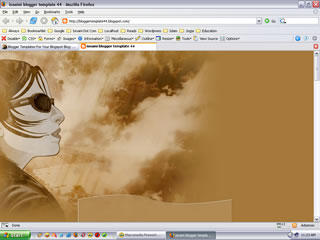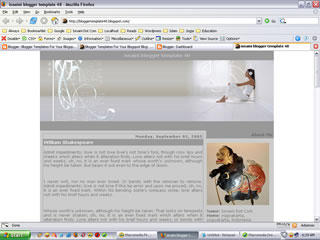Sourav Chandidas Ganguly also known as "Dada" is an Indian cricketer. Born 8 July 1972, lives at Barisha in Kolkata, formerly Calcutta, West Bengal, he made his One Day International debut against Australia in 1992, and a Test debut versus England in 1996. He went on to become the captain of Indian cricket team from 2000 to 2005. He has led India to the World Cup 2003 finals, and holds the Indian captaincy record for the most Test victories. Following an exit from the national team in early 2006, he was recalled to the Indian Test side in December, staging a successful comeback in the 2006 - 2007 Indian tour of South Africa.
Ganguly is a left-handed batsman and a right-handed medium-pace bowler. He is a natural right-hander, but converted to the southpaw stance at a young age so that he could use his left-handed brother, Snehasish Ganguly's equipment.
Nicknamed Bengal Tiger, Prince of Calcutta and also affectionately called Dada (elder brother in Bengali) by his team-mates and Lord Snooty by his opponents, he is an aggressive player on and off the field. He made his one-day international debut in 1992, but his talents did not truly receive the recognition they deserved until India's 1996 tour of England when he scored centuries both in his debut Test as well as the next match (the second and third Tests of the series). Ganguly is only the third cricketer ever to score a century on debut at Lord's, after Harry Graham and John Hampshire (Andrew Strauss has also since accomplished the feat). Rahul Dravid once commented, "On the off-side, first there is God, then there is Ganguly”. He scored 183 against Sri Lanka at Taunton in the 1999 Cricket World Cup, the highest by an Indian in World Cup cricket. He became captain within a year after the world cup and scored 2 centuries in the 2000 champions trophy immediately after. While he has achieved significant successes as captain, his individual performance deteriorated during his captaincy, especially after successes in the world cup and the tour of Australia in 2003 and the Pakistan series in 2004. Following indifferent form in 2004 and poor form form in 2005, he was dropped from the team in October 2005. He has since remained active on the first class cricket scene in hopes of a recall, but his performance has been mixed - he has hit a couple of centuries in domestic cricket, but his English county stint in 2005 and subsequent appearances in the Challenger Trophy were failures.
Consistent batting failures of the Indian cricket team, more so than his own mediocre to good performances in the domestic circuit led to his recall to the Indian Test squad in November 2006. Although India lost 2-1, Sourav Ganguly was the highest run getter for India, and only batsman to hit more than 200 runs in total. On January 12th 2007 he was recalled for the one day squad as well, where India play host to West Indies and Sri Lanka in a one day tournament. On January 21st, Ganguly hit a match winning 98 against the West Indies.
Sourav Ganguly made his international debut against Australia in India's tour of Australia in 1992. He didn't score much and was dropped from further matches. Four years later, following a good domestic record, he was recalled into the national side for a Test series against England in England. He made his Test debut at Lords, with a century in that match and repeated the feat in the match which followed. He was retained for the One day team and he went on become a regular in both forms of the game. One of his most memorable performance was in the final of the Independence cup at Dhaka against Pakistan, when the entire Pakistan team walked back in stating bad light along with the umpires, but Ganguly refused to come in. Ganguly scored 124 in that match in darkness, while Hrishikesh Kanitkar scored the winning runs with a boundary.
In 2000, after the match fixing scandal Ganguly was named the captain of the India team. In 2003 under his captaincy India reached the World Cup Final, where they lost to the Australians. Ganguly has scored over 10,000 runs in One Day Cricket and over 5,000 runs in Test cricket, including 12 centuries in Tests and 22 in ODIs. In terms of number of centuries in ODIs, he is exceeded by Sachin Tendulkar and Sanath Jayasuriya. Sourav, along with Sachin Tendulkar, formed by far the most successful opening pair in One Day Cricket, having amassed the highest number of century partnerships (16) for the first wicket. Together, they have scored 5,308 runs at an average of 45.37. Sourav has been succeeded by Virender Sehwag as opener.
He is the third player to cross 10,000 ODI runs and so far the fastest one to do so, after Sachin Tendulkar and Inzamam Ul Haq, and reached 6000, 7000, 8000 and 9000 ODI runs milestones in least number of matches played. Sourav can bowl medium-pacers as well, but has under-achieved in this aspect in Test matches, taking 25 wickets in 84 matches, at an average of 52.47. In 2004, he was awarded the Padma Shri. As of 2006, he is the only Indian captain to win a Test series in Pakistan (although two of the three tests of that series was led by Rahul Dravid).
Sourav Ganguly's 10 year international cricket career could be easily bisected into 2 halves, the pre and the post Y2K eras. The significance of the year 2000 lies not only in the fact that he became the captain of the Indian team but also in the fact that the ICC introduced the one bouncer per over rule in ODIs starting from that year. This introduction of the rule by the ICC had a negative impact on Sourav Ganguly's batting average, which plunged from a high 45.5 before the year 2000 to a low 34.9 between the 5 year period of 2001-2005. Also, against Test playing nations (which included Zimbabwe and Bangladesh), his overall average plunged further down to 30.66, as did his 'away' average which fell to 29. He managed to score only (6) centuries between 2001-2005, of which 3 centuries were against Kenya & 1 was against Namibia. This sudden drop in his batting average against Test playing nations after 2001 was clearly a result of the short pitch stuff he had to encounter from opposition bowlers. As S. Rajesh, the assistant editor of Cricinfo analyzes, Sourav Ganguly has been dismissed numerous times fending off the short ball since 2001 and his average of 11.92 against the short ball has been the lowest among contemporary Indian batsman who played more than 80 ODI matches. The former captain has also been uncomfortable while attempting the 'pull' and the 'hook' shots when bowlers have dug it in short, often lasting less than five(4.89) balls before being dismissed.
Also, Sourav Ganguly's Test career had been riddled with lean patches, the first of which stretched for 3 years from Dec 1999 to Dec 2002, during which his batting average fell to 31.7 in 36 consecutive Test matches over 60 innings. The next biggest lean patch of his career occurred after the 2003 World Cup, when his ODI average fell to 28 and this was when his place in the team was questioned by numerous Indian cricket fans. He averaged 23.5 in 20 ODI matches between Sep 2004 and Sep 2005, before being finally dropped from the ODI side.
Despite his hot and cold streaks Sourav Ganguly is only the third Indian Test match batsman to maintain a career average that never dipped below 40 runs per innings for his entire Test career. This is more due to his initial career graph, which plummeted alarmingly in the second half of his career. Whereas his contemporaries like Dravid, Tendulkar, Sehwag and Laxman have shown steady improvement in their career graphs, his own happens to have a pronounced downward trend. The other two who achieved this feat are Sunil Gavaskar and Mohammad Azharuddin.
Sourav Ganguly also shares with G. R. Viswanath of India the record for scoring at least 10 or more centuries and his team either winning or drawing each and every match in which he scored a century. He also shares with Mohammad Azharuddin the record of scoring two consecutive hundreds in his first two Test matches, though Azharuddin bettered that by scoring a third consecutive hundred in his first three Test matches.
Sourav Ganguly has the highest Test and ODI aggregate of any left-handed batsman India has produced and his 12 Test and 22 ODI centuries are also a record for any Indian left-hander.

It was, however, as captain of the Indian team that Sourav Ganguly's biggest achievements occurred. He led India in a record 49 Test Matches, winning 21 of those, including 12 of them outside India. All three figures are records for Indian Test captains. He also led India to her first series wins in both Tests and ODIs in Pakistan, a feat that had eluded India for over 50 years. Ganguly also led India to more Test wins (11) outside India between 2000 and 2005 than all Indian captains had done between 1980 and 2000. He led India to victory over Steve Waugh led Australia in the 2001 Border-Gavaskar trophy which is considered as one of the greatest in Indian cricket history. However, his captaincy record has no doubt been immensely helped by numerous series against the minnows Bangladesh and Zimbabwe. Against other teams, his captaincy record 12 wins and 12 losses, which is still better than other Indian captains. He also benefitted immensely from the peaking of all the great Indian players during his tenure - Sachin, Dravid, Laxman, Sehwag, Kumble, Srinath and Harbhajan.
November 30, 2006, turned out to be lucky for Sourav Ganguly as the national board of selectors, chaired by Dilip Vengsarkar, decided to reinstate him in the team for the three-Test series against South Africa. The decision came after India had been knocked out early of the Champions Trophy, held in India, as well as losing the opening three games of an ODI series with South Africa. The selectors decided to back experience in a total reversal of coach Greg Chappell's mission to inject fresh blood into the Indian cricket team and Ganguly was selected alongside VVS Laxman and Zaheer Khan, who had also been removed from the Test team recently. Ganguly and Zaheer both fared well. Ganguly emerged as leading run getter for India in the recently concluded Test series with South Africa.
January 12, 2007 Sourav Ganguly was reinstated to the ODI team for the first two ODIs against West Indies. This comes almost after 15 months of his removal from the ODI side in 2005. He staged a good comeback by scoring a match-winning 98 run knock in Nagpur on his return in the first ODI. He was also selected in the 30 probables list for World Cup 2007 to be held in West Indies starting in March. He will most likely open the innings with Tendulkar as Virender Sehwag has been dropped for the first two ODIs.
This was good news to his fans who believed that India's most successful captain deserved the farewell of a champion. Sourav is a passionate man and fans (possibly selectors too) believe that, after spending ten months in the wilderness, Sourav's desire to succeed at the highest level and his experience will hold him in good stead.
Controversies:
Ganguly is an aggressive player and has often attracted controversy. He has attracted the wrath of match referrees quite a few times, the most severe of which was a ban for 6 matches by ICC match referee Clive Lloyd for slow over rates against Pakistan and therefore his tour to Sri Lanka for the Indian Oil Cup 2005 was uncertain. These circumstances led to Rahul Dravid being made captain for the tour. Later, Justice Albey Sachs reduced the punishment from 6 matches to 4, and this permitted Ganguly to join the team, but as a player and not captain. In his opening match he made the highest score of the side (51) taking (110) balls. He was again named captain for the Zimbabwe tour of August-September 2005. With this, he has captained India in the highest number of Tests (50).
During the 2003 World Cup final against Australia, Ganguly won the toss and decided to field. This decision raised eyebrows but Sourav remained confident that there would be moisture on the pitch that would help his bowlers, however the bowlers flopped and Sourav performed poorly with the bat. India went on to lose by 125 runs, a staggering defeat.
Ganguly's performance in the last couple of seasons has been really poor. This put his place in the Indian team under pressure. In the tour of Zimbabwe, in which he was newly reinstated as skipper, Ganguly ground out a painfully slow century, against what is regarded as one of the weakest bowling attacks in international cricket. During the match he told reporters that newly-appointed coach Greg Chappell had asked him to stand down as captain - a comment which Chappell later played down. However, forty-eight hours after saying that he respected the Indian captain and looked forward to working with him in the future, Chappell sent an email to the Board of Control for Cricket in India (BCCI). Both Ganguly and Chappell were summoned to a BCCI board meeting in which they agreed to work together for the good of the team. Rahul Dravid was appointed captain for the series against Sri Lanka and South Africa after Ganguly was not selected for the opening games due to injury. When the two series got over, Rahul Dravid was asked to continue as skipper.
On November 22, 2005, Ganguly stepped down as captain of Bengal cricket team after being replaced as captain of the Indian Test team. He played in the first two Test matches in the three-Test series against Sri Lanka. However, on December 14, he was controversially dropped, for the third Test at Ahmedabad, to make way for Wasim Jaffer, an opening batsman for Mumbai. Jaffer was picked by the selectors as they wished to build up a player selection pool with sufficient experience to succeed at international level.
Despite this, he retained his A-grade contract from the BCCI, in December 2005.
Following the drop, fans blocked roads and railway tracks in Kolkata, burning effigies of chief selector Kiran More and Indian coach Chappell, and the urban development minister of West Bengal, Asoke Bhattacharya, said Ganguly was a victim of the internal politics of the BCCI. [9] Cricinfo editor Sambit Bal wrote in a commentary that this was in all probability ... the end of the road for him. [10] However, it was announced on December 25, 2005 that he was selected as part of the Indian team to tour Pakistan. Kiran More cited his experience as the key reason, with Mohammed Kaif being dropped [11]. He was in the playing XI in the Lahore and Karachi Tests, but was dropped for the Faisalabad match, and has not been recalled since. He was unable to play in the England home series and the West Indies tour. He was also not selected for the following Tri-series in Sri Lanka. However, he was chosen amongst 30 probables for the ICC Champions Trophy after being left out in the dark for almost close to a year. Ganguly failed in the Challenger Trophy, however, managing less than 30 runs in two games, and so the chances of recall to the ODI side look bleak.
Ganguly later sent an email hitting out at his one time mentor saying that Jagmohan Dalmiya did not deserve to become CAB president as he had played with his career and that Ganguly was a victim of internal politics within the BCCI. This was in the backdrop of the CAB elections which Jagmohan Dalmiya won.
Comeback:
After being dropped from the side for almost eight months, Ganguly was recalled to the Test team for the series against South Africa in December 2006, after an injury to Yuvraj Singh. And after the recall, in his first warm up match against rest of South Africa, he scored fantastic 83 runs when his team was in troublesome position at 69/5. this knock helped India win against rest of South Africa.
He went on to play a crucial knock in the first test match, scoring 51 not out in the first innings in a low scoring game. India went on to win the match, its first win in South African soil for 17 years. Though India ended up losing the next two test matches and thus the series, Ganguly emerged as the top run scorer for India, with an aggregate of 214.
Selected for the one-day team after his successful Test comeback, he started the series against West Indies with a fluent 98, which led to India winning the match. He played his last international ODI before 500 days. After being rested for the third ODI, he again answered his critics with a sparkling 68 in the final ODI to help India win the series 3-1.
Records
Test:


















